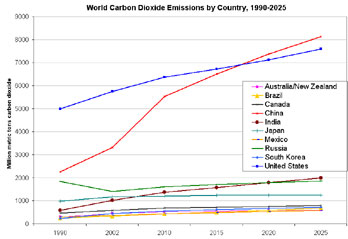Slowing global warming may be less costly than initially thought
Rhett A. Butler, mongabay.com
March 9, 2006
Preventing carbon dioxide levels from rising to potentially dangerous levels could cost less far less than originally projected—less 1 percent of gross world product as of 2050—but a major shift in the way energy is found, transformed, transported and used will be necessary to prevent a severe energy crisis within the next century, say researchers from the The Earth Institute.
In a report published in the most recent issue of Brookings Papers on Economic Activity, Klaus S. Lackner and Jeffrey D. Sachs of The Earth Institute argue that significant technological developments will be required to meet future energy needs and stave off potential cataclysmic effects of climate change.
“Today’s technology base is insufficient to provide clean and plentiful energy for 9 billion people,” the authors write. “To satisfy tomorrow’s energy needs, it will not be enough simply to apply current best practices. Instead, new technologies, especially carbon capture and sequestration at large industrial plants, will need to be brought to maturity.”
According to the report, primary energy use worldwide is currently about 14 billion kilowatts (kW) each year, translating to about 2.2 kW per person. However, there are wide variations in energy use between industrialized countries and the developing world. For example, residents of the U.S. use 11 kW per person, 85 percent of which comes from the combustion of fossil fuels, which contributes to the rising level of carbon dioxide in the Earth’s atmosphere. As the developing world—especially China and India—catches up to the United States, their energy use and carbon emissions are expected to grow significantly.
“Technology in general and energy at its base ultimately define the carrying capacity of the Earth for humans,” says Lackner, director of the Center for Sustainable Energy at the Earth Institute. “If the rest of the world consumed carbon at the U.S. rate, carbon consumption and emissions worldwide would be six times what they are today. This would not only exhaust available oil supplies by the end of the century or sooner, but would also threaten widespread environmental damage.”
 Projected carbon dioxide emissions, 1990-2025, by country. More energy charts. |
By 2025, the share of globl carbon emissions from developing countries is expected to grow from 41 percent to 60 percent. By the end of the century, their share could reach 80 percent of global emissions.
Globally, primary energy use releases 25 billion tons of carbon dioxide into the atmosphere each year. In the 250 years since the Industrial Revolution, the concentration of carbon dioxide in the Earth’s atmosphere have climbed by more than 35 percent to about 380 parts per million (ppm). Climatologists say that at current rates, atmospheric carbon dioxide levels could reach 550 ppm by mid-century, producing a significant impact on global climate and resulting in increased acification of the world’s oceans.
To preempt this scenario, Lackner and Sachs say that new technologies—including solar energy, clean coal technology, hybrid engines and nuclear power—will be key to meet the world’s growing energy needs without threatening to destabilize the Earth’s climate. The authors also identify carbon capture and sequestration as an important part of any future plan to address rising carbon dioxide concentrations.
“Whatever we do, we know we are going to have to approach this complex problem in a multi-faceted way and from a global perspective,” said Sachs, director of The Earth Institute at Columbia University. “The key is we have to start now and we have to commit ourselves to making a change before change is forced on us. Fortunately, there are promising technologies that may well offer us solutions at large scale and reasonably low cost.”
Lackner and Sachs estimate that a program to moderate the Earth’s carbon dioxide levels could cost less than 1 percent of projected gross world product as of 2050.
This article is based on press materials from Columbia University.